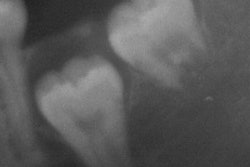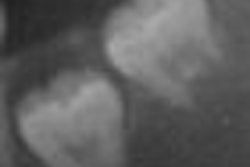
For many Americans, conventional wisdom says that third-molar extraction is part of growing up. Meanwhile, in dentistry, there is considerable debate about the clinical indications that should lead to third-molar extractions.
A new study published in the Journal of Oral and Maxillofacial Surgery has found support for the removal of third molars in patients with only mild symptoms of pericoronitis (October 2013, Vol. 71:10, pp. 1639-1646). "Removal of third molars in patients with mild pericoronitis symptoms improved the periodontal status of the D2Ms [distal side of the second molars] and teeth more anterior of the mouth," wrote researchers from the University of North Carolina (UNC) School of Dentistry in Chapel Hill.
The extraction of third molars as a result of pericoronitis is controversial, the researchers acknowledged. Indeed, Jay Friedman, DDS, MPH, an outspoken critic of the frequency with which third-molar extractions take place, took issue with the researchers' "definition of pericoronitis based on the patient's self-assessment of 'mild symptoms,' " calling it "unacceptable" in an email to DrBicuspid.com.
Nonetheless, pericoronitis has been associated with third-molar extractions and not just among young adults, who are most frequently diagnosed with it. A Journal of the American Dental Association study of third-molar extractions in some 300 patients older than age 35 found that 41% were for pericoronitis (August 1980, Vol. 101:2 pp. 240-245). Patients older than 40 had similar extraction rates for pericoronitis in another study.
Published guidelines have differing recommendations about when it is appropriate to extract third molars for pericoronitis, and, consequently, the authors of the current study called for "more definitive, evidence-based guidelines on this topic."
The researchers gathered data for the prospective longitudinal study from patients between the ages of 18 and 35 enrolled from 2006 through 2012 at UNC. "This is not your typical individual across the U.S., and it isn't a population-based study," explained Ray White, DDS, PhD, a professor in the department of oral and maxillofacial surgery at UNC. "They continued with regular dental care: 90% brushed twice per day and had flossed the day the before," he noted, adding that 90% had at least some college education.
Those with signs of major pericoronitis, severe periodontal disease, or medical contraindication to full-mouth probing were excluded. Tobacco use, a high body mass index, pregnancy, antibiotic use within the preceding two months, and acute illness also were grounds for exclusion.
The researchers collected periodontal probing depth (PD) data at six sites per tooth during enrollment. For those patients included in the study, "we collected biofilm samples; we also collected inflammatory mediator samples from the gingival crevicular fluid," Dr. White explained. "Then we did six places per tooth of periodontal probing all the way around."
The researchers rounded PD down to the nearest lower whole number, so a PD of 4.6 mm was rounded to 4.0 mm. And a periodontal PD of at least 4 (PD4+) was classified as a clinical indicator of periodontal inflammatory disease, the researchers explained. They also assessed the presence of PD4+ on the distal side of the second molar (D2M) or anterior of the D2M, the number of PD4+s, and extent scores for PD4+ at the patient and jaw levels.
The researchers included 69 patients with mild pericoronitis symptoms who had all four third molars removed in their study and an average postsurgical follow-up time of 4.9 months.
The researchers noted more periodontal pathology in the mandible. They also found that "the proportion of patients with at least 1 PD4+ on any D2M at enrollment decreased significantly after surgery." While 88% of the included patients had one or more D2Ms with PD4+ at enrollment, the figure dropped to 46% at follow-up (p < 0.01). They also noted improvement in 33 of the 61 patients with D2M PD4+ at enrollment after surgery. And significantly fewer patients, 29%, had one or more PD4+ anterior to the D2M detected at postsurgical follow-up, the researchers wrote.
The researchers acknowledged limitations to the study and the need for more research. However, "these finding should assist clinicians when counseling patients with mild symptoms of pericoronitis who seek advice regarding third-molar management," they concluded.
In his comments on the research, Dr. Friedman took issue with the average age of the study participants, 21.8, and noted that their discomfort could simply be a result of eruption.
In response, Dr. White said he and his fellow UNC researchers "looked at maybe 100 who had teeth that were not at the occlusal plane using a panoramic x-ray and followed them over time."
"So it was clear that, in almost every case, the teeth either erupted to the occlusal plane, went from not being probed to probed, or changed angulation over a four- to five-year time frame," Dr. White said. "Whatever you got when you started, they didn't stay in that position. A logical question to ask is, 'Why are third molars different than first or second?' Clearly, there is plenty of space when first and second molars erupt."



















